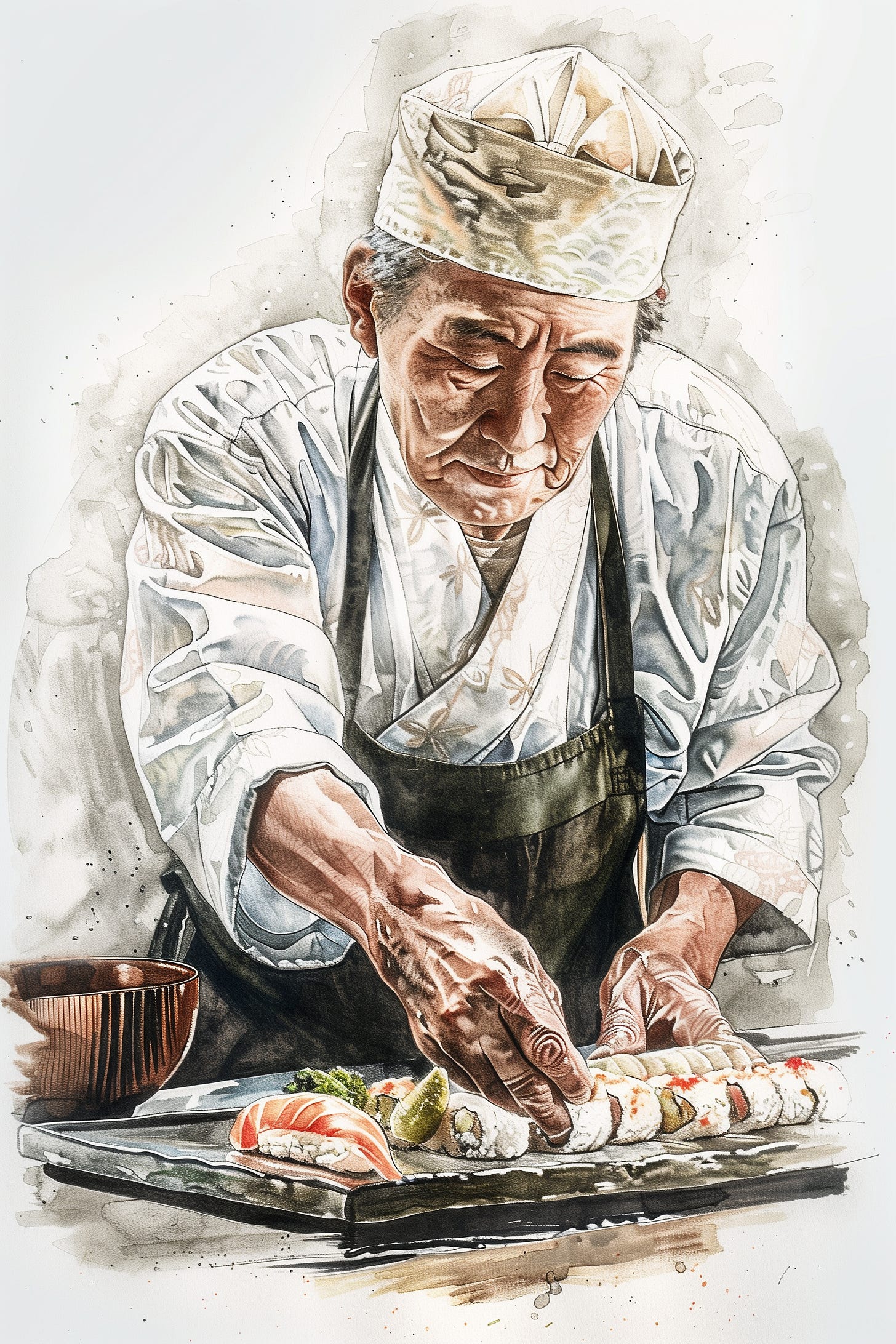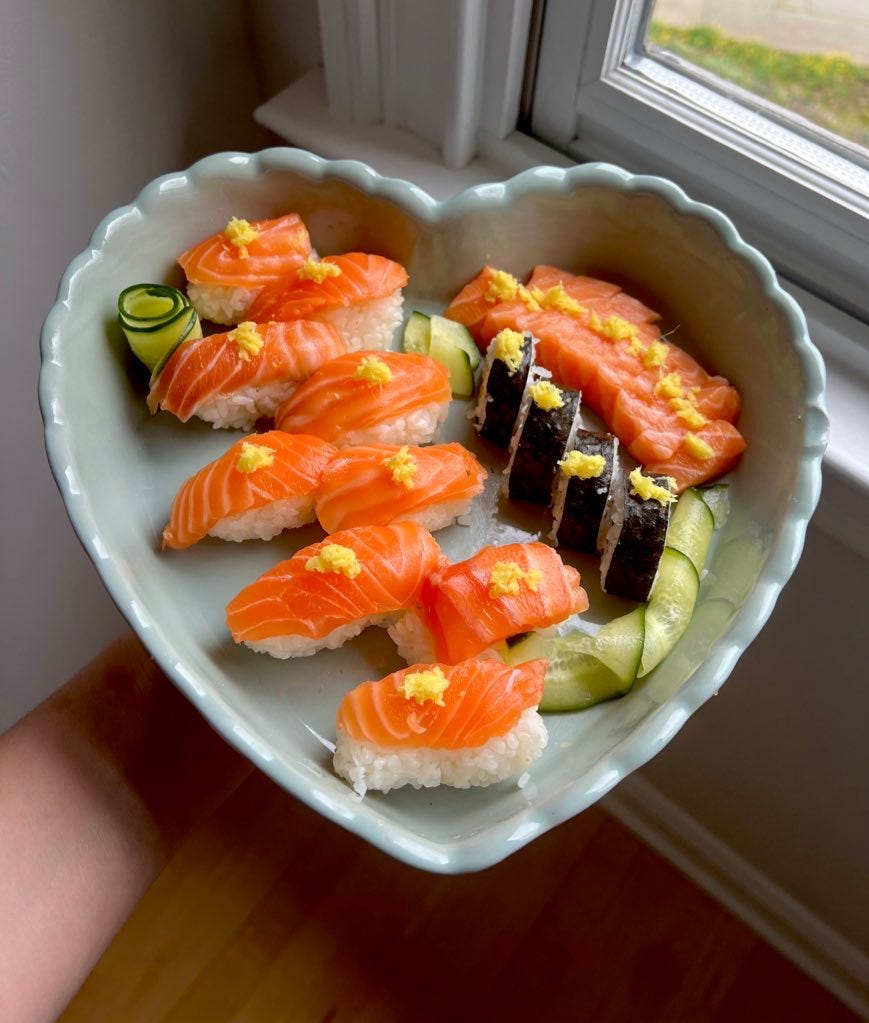The Lost Art of Sushi
Sushi Recipe Included
Imagine. You’re sitting on a dock in ancient East Asia. The sun reflects off the calm sea, and the air buzzes with the energy of shouting fishermen and bustling activity. Your cheeks are tingling with nitric oxide. Nearby, a fishermen cleans a freshly caught mackerel. Peering into his boat, you see him planning for the harsh winter months ahead. Without modern refrigeration—remember, you’re a thousand years in the past—he resorts to the only preservation method available: narezushi. He starts by covering the fish with rice for its initial marination. In a few days, he will layer the fish in a mixture of rice bran and salt, firmly weigh it down, and let it ferment for a year. Once this period is over, he’ll cleanse the fish, stuff it, and marinate it again in a barrel of rice, discarding the rice after several weeks. By winter, narezushi will finally be ready. Come cold weather, his family will enjoy the soft notes of mackerel with a hint of acidity and no concern of it going bad. Instead, it will be edible—and better yet, delicious—for as long as they can make it last.
Looking back over the last couple of thousand years, sushi has always been popular, but the version we know today—raw fish wrapped in fresh rice and dipped in silky soy sauce—only became widely recognized more recently. The term “sushi” comes from the Japanese word for “sour,” which more accurately describes narezushi, the original form of sushi, rather than the modern delicacy we enjoy today.
Ancient fishermen knew what they were doing when they created narezushi. Fish is tasty, but the nutrients packed in each bite can make your eyes shimmer, your brain sharper, and your mood serene.
Minimally processed whole foods are powerful. They come with perfectly balanced cofactors that not only work together, but also allow our bodies to efficiently absorb them. When it comes to sushi, the elusive omega-3 fatty acids deserve the spotlight. Among them, DHA is arguably the most important compound in our evolutionary history. Our ability to accumulate higher amounts of DHA in the brain helped us surpass other primates. It’s DHA that lets the sun synchronize our internal clocks and helps produce and protect the dopamine that drives us. DHA also modulates the immune system to reduce inflammation, regulates leptin synthesis, and binds various forms of vitamin A to facilitate the conversion of LDL cholesterol to pregnenolone—the precursor to virtually every steroid hormone. The list goes on, but suffice it to say, we don’t function without omega-3.
Divinely inspired or not, sushi is often paired with local produce to not only enhance its flavor profile but also synergize with the fish for optimal vitality. Ginger is one such addition. It adds zest to what would otherwise be a “round” flavor profile and provides the gut with prebiotic fiber. Its antimicrobial properties make sense through the lens of raw food. But that’s not all—ginger is also known for its longevity-promoting properties through its high antioxidant activity and lipofuscin inhibition. However, the dose makes the poison, and ginger is no different—gingerols can inhibit melanin synthesis, which would be detrimental for those lacking sunlight exposure. If you’re not yet melaninpilled, trust me on this one: more is better.
As ginger’s first cousin, wasabi offers many of the same benefits, but it’s not why we use it. We do so for its pungency! Few flavors are as vibrant as a perfect nigiri bite with a small dot of wasabi.
This brings us to the final addon: soy sauce. When done right, it’s a powerful umami booster and typically your sushi’s last pit stop before making its way into your mouth. As a fermented food, it’s packed with minerals and bioactive peptides. Some enhance your sodium receptors, allowing you to taste more with less, while others benefit overall health—some even improve lipid metabolism, helping you digest your fatty fish more efficiently.
Contrary to popular belief, soy sauce is unlikely to turn you into a soyboy. Its phytoestrogens, known as isoflavones, compete for estrogen receptors and exert a weak estrogenic effect compared to estrogen. For women, it might even help with estrogen dominance! But don’t overdo it; the main contraindication of soy sauce is the use of glyphosate in most, which replaces glycine in our tissues. So if you opt for soy sauce, choose an artisan or organic brand, as organic farming regulations prohibit the use of glyphosate. Otherwise, you can always go with coconut aminos!
Honorable mentions: nori and fish roe—for their iodine and DHA, respectively.
True sushi chefs spend years, even decades, mastering the art of sushi. When presented at a restaurant, sushi might seem simple, yet it’s more than meets the eye, with multiple layers of complexity woven throughout the preparation process.
Too much rice overpowers the fish. Not enough, and the flavor profile is off. If the rice is too tightly packed, the bite will be hard. Too loose, and the sushi will fall apart upon meeting your chopsticks. And all the while, the beauty of sushi must never be compromised.
Most of us don’t have decades to learn, nor a sushi master mentor to train us. However, that’s no reason not to join in on the fun of making sushi for your next date night or to share with family and friends! Just be sure to toss the leftover odds and ends to your dog, so they can join in on the fun too.
As you plan your sushi menu for optimal health and to connect with nature, consider letting the seasons guide you. You’ll be working with three types: nigiri, maki, and sashimi. Nigiri are little mounds of rice topped with a perfectly sliced piece of fish. Maki adds bite-sized color to your life with additions like avocado, cucumber, or even fruit if you’re adventurous, all wrapped in nori. Then there’s sashimi, the purest form of sushi—just fish and nothing more.
With spring here, prioritize nigiri. The sun is just beginning to make an appearance, so it’s a good time to introduce rice—in moderation. As we transition to summer, and hopefully you’ll be basking in the sun from sunrise to sunset, turn to maki for your fix of fresh produce braided with fish and rolled up in rice. Continue to generously indulge in nigiri and sashimi all summer long. In autumn, as you get fewer kisses from the sun, alternate between nigiri, maki, and sashimi. By winter, with cold temperatures and limited sunlight, drop the extras and focus on sashimi.
Listen to your environment. On sunny days, regardless of the season, enjoy all kinds of sushi. The food we eat is shaped by light. When the light environment in which our food is grown differs from our own, our mitochondria don’t function at their best.
If there’s a sushi chef reading this, I might be criticized for saying this, but I believe there’s no golden rule for good or bad sushi. We must listen to our bodies. Some of us need more sodium, while others prefer more acidity. Use my recipe as a starting point for perfecting your own sushi rice and discovering your favorite combinations.
Sushi Recipe
Ingredients
2 cups Japanese short-grain rice (“sushi rice”)
3 cups water
6 tablespoons unseasoned rice vinegar
6 teaspoons sugar
1.5 teaspoon salt
Fish of your choosing
Optional: ginger, wasabi, fish roe
Method
Rinse the rice until the water runs clear.
Cook it according to the package instructions.
Heat the rice vinegar, sugar, and salt, in a saucepan over medium-heat until simmering. Remove from heat and whisk until sugar is dissolved.
In a large mixing bowl, drizzle the rice with the sushi vinegar, folding carefully until evenly mixed.
Cover the mixing bowl with a damp towel so that it is touching the rice. Let it cool on the counter until it reaches room temperature.
Slice your fish at a 45º angle with a sharp knife
Now to assemble! Have fun. Experiment with nori, produce, and different types of fish. Keep the seasonal guide in mind! Sushi is a world of fascination and fun, and it goes far beyond the delicious taste. Make some of your own sushi at home while imagining yourself on a Japanese dock under the sun. Relish in the fact that this food is nourishing your body. And you know, narezushi just might be next on my list of culinary experiments. I’ll keep you updated.
This article and sushi recipe was written by LadyOfOurSun. Reach her on X(Twitter).
This article was originally published in Issue 24 of the WARKITCHEN Magazine.
P.S. Adding us (rocky@warkitchen.net) to your contacts, or moving us to primary will make sure you continue receiving these emails. Access the rest of our magazines and all of our links here. Have a powerful day 🥂








